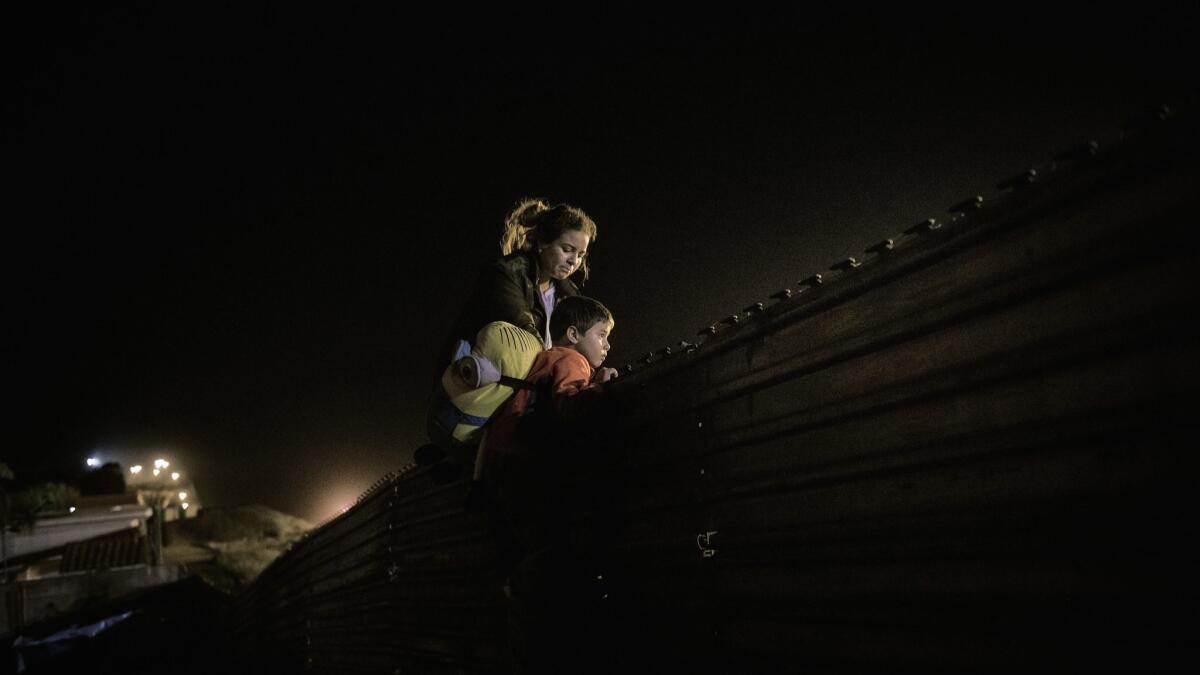Another, bigger migrant caravan is set to leave from Honduras next month

- Share via
Another migrant caravan — with estimates of as many as 15,000 participants — is preparing to leave Honduras on January 15, according to migrant rights advocates and Spanish-language media.
“They say they are even bigger and stronger than the last caravan,” said Irma Garrido, a member of the migrant advocacy group Reactiva Tijuana Foundation.
Meanwhile, thousands of Central American migrants from a caravan that left Honduras in October remain stranded at the U.S.-Mexico border and languishing in crowded Tijuana shelters while they wait out a lengthy process to file asylum requests with the United States.
Coordinators who helped direct the migrants on the 2,000-mile trek with bullhorns, arranging for buses and giving advice along the way, have mostly vanished. Many of the migrants say they feel abandoned and unsure where to turn next. Some are ready to return home.
Garrido said this new, larger caravan will likely be joined by more people in El Salvador and in Guatemala, but she said they don’t plan on coming straight to the Tijuana-San Diego border, where resources are already stretched nearly to a breaking point.
“They will stay in the south of Mexico in Chiapas and Oaxaca. Their aim is to request work there,” she said.
Mexico’s President Andrés Manuel López Obrador has pledged visas and work in Mexico for Central American migrants. In his inauguration speech, he pledged public works projects like planting two million trees and construction of his Maya Train, a 1,500-kilometer railroad. It will link cities in the three Yucatan peninsula states as well as Tabasco and Chiapas.
The $8 billion project is expected to create hundreds of thousands of jobs in the southern states of Mexico.
Last week, Mexico and the United States agreed to develop a plan to curb Central American migration. The plan includes a $25 billion investment from Mexico into its southern states over the next five years. The United States will contribute $4.8 billion to Mexico and $5.8 billion to the Northern Triangle of Central America, which is made up of Guatemala, Honduras and El Salvador. Most of the United States funding will be allocated from existing aid programs.
El Diario de Chiapas, a newspaper for the southern state of Mexico, reported that — like the last caravan — news about the groups’ plans to leave Honduras, their numbers and which routes they would be taking is spreading mostly by social media.
On Facebook, reaction in Chiapas to news of a second caravan was not all favorable.
“Well, now the government does something. That work is for Mexicans that need it,” said Anna Pérez from Palenque, Chiapas, Mexico on Facebook. “Opportunistic people who just want to take advantage of the Mexicans.”
The caravan that left Honduras in October, drawing the ire of U.S. President Donald Trump and capturing international media attention, was not the first. Crowds of migrants often travel together in groups for protection from criminals that stalk the routes.
Pueblo Sin Fronteras has led migrant caravans from Central America for more than 15 years, usually bringing the largest crowds just before Easter.
The organization and its work was relatively unknown to most Americans until the president began tweeting about the caravan ahead of the midterm elections.
The El Diario de Chiapas newspaper reported some of the new caravan participants eventually plan to make their way north to Tijuana and try to enter the United States, but that would not be their initial destination.
In Tijuana, presence of Central American migrants has sparked protest and even violence.
Last week, two people threw a canister of tear gas into El Barretal shelter, according to Mexican federal police.
On Dec. 15, two Honduran teenagers were viciously beaten, tortured and killed by low-level members of the Cártel Jalisco Nueva Generacion, highlighting the dangers for unaccompanied minors in the caravan.
After the teenagers’ deaths, the Consulate of Honduras issued a warning: “We reiterate the call to Honduran nationals that they not risk their lives and the lives of their families on the dangers that the migratory route represents, where migrants are exposed to being victims of traffickers,” the statement read in Spanish.
Thousands remain stuck in Tijuana, a city with more than 2,000 homicides this year, leaving the Central American migrants almost as vulnerable as they were grappling with the gang violence that caused them to flee their homeland.
More to Read
Sign up for Essential California
The most important California stories and recommendations in your inbox every morning.
You may occasionally receive promotional content from the Los Angeles Times.














